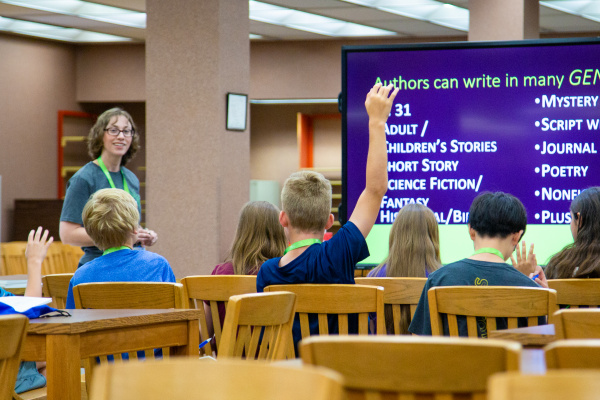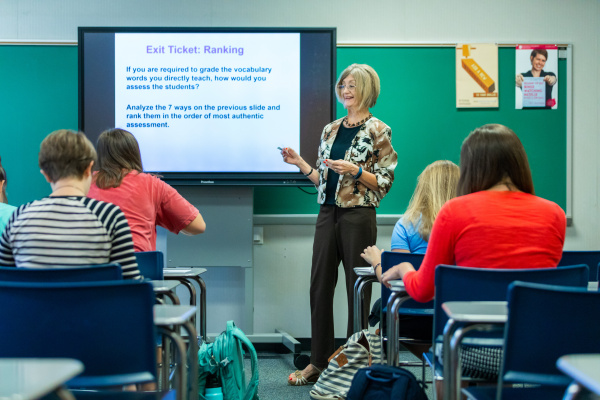During college, planning English lessons seemed no different to me than planning a lesson for another subject. Even planning whole units or long-range planning didn’t seem too daunting. Of course, my kind professors helped me a great deal, and my imaginary students didn’t mess up any of my perfect plans.
I remember my first day in my classroom. I looked at all the textbooks—grammar and writing, literature, and vocabulary—and wondered where to start. No one had left me any ideas of what had been done before. I was starting from scratch. Still, I had learned how to do this, so I made my plans.
But then, the students came with their different personalities, learning needs and styles, and backgrounds. I learned that my plans were not always going to happen without changes, but I also realized the expectation that these students and parents had to be prepared for the next grade. I knew I had to figure this out quickly!
Many, many years have since passed, and I have since realized what is needful, what is doable, and what needs to be thrown out the window. My picture of planning for a class that covers so much is of a juggler. My juggling balls, if you will, are the curriculum and standards I need to cover throughout the year. An amateur will drop a ball, but a professional knows how to keep all the balls flying smoothly.
Establish priorities
When tackling the to-do list for the English classroom, deciding what is most important is key. It is easy to think that every page of every text must be covered, but a textbook is a guide not a governor. Having a minimum plan and then assessing students informally and formally will help you know just how much is needed, especially in grammar.
Reviewing standards and a school’s scope and sequence helps a teacher know what must be covered and what others will be working on in class. Of course, if one teacher covers all the secondary grades, that conference will be short! Don’t try to teach twelfth-grade material to seventh graders, though. Not all students are ready to hear your college lessons, and while we often have stories, writing activities and such that we want to add to the lessons, make sure that it will not steal the thunder or discredit what another grade or class may have planned.
Combine and alternate
Different systems of thought exist as to having all grammar and then all literature or interspersing them. My philosophy is that they work together, so I teach them simultaneously, though emphasizing one more than the other in any given week. Writing should be a part of both, and vocabulary/spelling easily stems from literature. Combining grammar and writing then alternating with the combination of literature and vocabulary and/or writing can help students make connections and adds some spice to the classroom.
Exhibit relevance
Connecting material—sentences, activities, reading or writing—to present school and life situations helps students see the relevance to their current lives and their future. They will still question the need to label or analyze, but these skills will be useful in so many ways in the future, far beyond the grammar lessons. Literature might seem old or a different genre than their preference, but use the analyzing skills to look at modern situations as well. What are the comparisons to the story or to history? How could they continue to be needed?
Review and build
Teaching grammar reminds me of ocean waves. The waves move and crest, and it almost appears that they are coming back to collect more water to make the next crest bigger. In class, we move forward with a concept and hit a crest. Then we go back a little to review and reinforce, surging forward to the next crest.
This may seem like more work, not less, is being created, yet the reinforcing and bringing it all together makes for a stronger student who is ready to move forward even more. Short reinforcing activities may help more than belaboring worksheets, and meaningful topics make it seem more interesting than work that would never be used again.
See Also: Teachers Tackling Technology in the Secondary Classroom
Make it yours
If teaching becomes another page, another lesson, another test, it is likely that the material has remained stagnant for you over time. While no one wants to start each year’s lessons from scratch, students can see right through your scheme if year after year everything is the same. I tell my students that no one’s writing is perfect the first time it is written; there is always room to improve. The same is true for a teacher—make improvements. Use a fresh perspective and search for more background, new images, extra explanations or additional reinforcements. Even adding to the material in the textbook is perfectly acceptable. As the teacher, you use tools to help you reach the students you currently have in your classroom. A textbook is a tool to aid that, not confine or bore you. The more you enjoy a topic, the more the students will too.
Enact a plan
How does this all fit together for accomplishing the lessons needed in an English classroom (or any other, for that matter)? It starts with the students, not the textbook. It takes them from where they are to where they need to be. Prioritize, organize, and then energize your lessons into just what those students need.
Students will remember you less if you keep all the balls in the air but never notice the students in front of you. They will remember you forever if you realize that setting a ball down to help them is more important than perfection.








